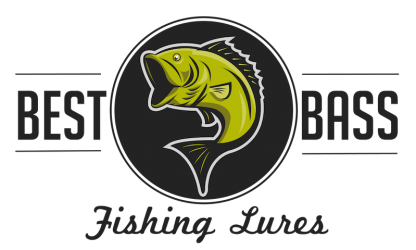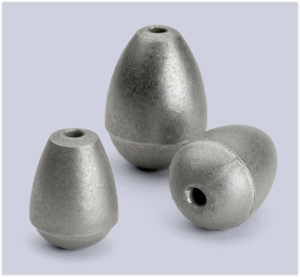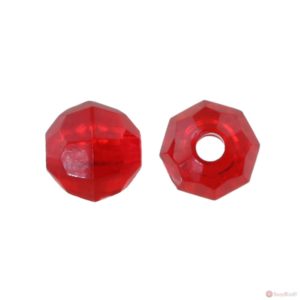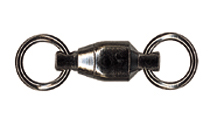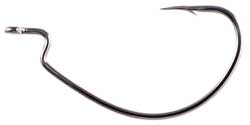The Carolina Rig is not only a way to rig a worm but also a technique for bass fishing. It shares some similarity to the Texas Rig in the way that the actual worm is rigged, but that’s about it.
Unlike Texas Rigs, Carolina Rigs utilize a leader to keep the weight fixed a set distance from the worm. The mainline from the reel is threaded through a weight and bead, and then tied to a swivel. On the other end of the swivel is a length of line which is known as a leader. At the other end of the leader is the hook and plastic worm.
This rigging allows the worm to glide naturally through the water, since the line tension from the rod is only directly affecting the weight’s movement. As you pull the weight along the bottom, the worm is towed along by the weight.
Fishing a Carolina Rig creates an attractive, natural looking presentation just above the bottom. Not only a natural look, but a natural feel too. When a bass bites the worm they don’t feel the heavy weight, and as a result will hold on longer.
Carolina Rig Components
There are a few components involved in a Carolina Rig, and we will go through all of them, but here is a quick list of what’s required:
- Weight
- Bead
- Swivel
- Leader
- Worm Hook
- Soft Plastic Worm
If you’re looking to try Carolina Rigging and want to get everything in one shot, then check out this Carolina Rig Kit. It’s a complete set of the required tackle needed for Carolina rigging. Now let’s get in to the components.
Carolina Weights
Choosing a weight for a Carolina Rig is mostly related to the depth of water you’re fishing, but it’s also a matter of personal preference. Some anglers just prefer a heavy weight so they get better feel on the bottom.
Typically you won’t see a Carolina Rig fished with anything less than a half ounce weight. Half ounce and three quarter ounce weights are most popular, but it’s not uncommon to see fishermen using one ounce or heavier.
The best weight for a Carolina Rig is an egg sinker or bullet weight. These are slip sinkers, meaning they have a hole through the center of them that the line is threaded through. The weight can slide freely along the line as it’s dragged along the bottom.
Egg sinkers do a better job of stirring up the bottom and attracting more attention from bass. Bullet weights are better when you are fishing grass or other vegetation because the pointed head makes them pull through better. The weights can be made of lead, steel, or tungsten, all will work just fine.
Beads
The bead serves two purposes on the Carolina Rig. First it acts as a protective buffer between the weight and the knot on the swivel. This prevents the knot from becoming damaged from the weight smashing up against it.
Second, it creates a nice clacking noise when it comes in contact with the weight. This noise is useful for getting the attention of nearby bass. You could also say that thirdly they throw out a bit of flash, since typically they are red and made of shiny glass or plastic.
The type of beads traditionally used are glass red faceted beads. They come in a range of sizes but most popular for the Carolina Rig are 8mm or 10mm. The reason most anglers prefer glass beads over plastic is they give off more of a clacking sound, they’re just more expensive than plastic.
Swivels
The swivel is what connects the mainline to the leader. It’s main purpose is keeping the weight a predetermined distance from the hook, but they also allow the bait to spin without causing a line twist. Although any swivel will suffice, a good quality one will perform better and last longer.
Worm Hooks
Typically the Carolina Rig is fished with worms on the smaller size, so for a hook you’d be looking at a 1/0 or 2/0 size. The best style is an offset worm hook, but a straight shank would work too.
The light wire gauge on these smaller hooks will help keep the worm from sinking to the bottom too quickly. You want the worm to flutter along and sink very slowly when at rest. The worm itself should be rigged Texas style on the hook.
Carolina Worms
The beauty of the Carolina Rig is you can fish it with just about any soft plastic bait. But the best worms for Carolina Rigging are small stick baits like Zoom Centipedes. These small baits have great movement with this rig because they’re so light.
Carolina Rig Leader
This is where opinions will vary the most amongst anglers. Some will use a leader that is ten inches long, while others will swear by a seven foot leader. A lot has to do with depth and water clarity.
A four foot leader will suffice in most clear water conditions. In clear water it’s good to have a longer leader, but seven feet is probably the longest you will see on a Carolina Rig.
The key is to put extra distance between the worm and the weight, so fish aren’t suspicious when they approach. For that same reason it also helps to use light pound test line for the leader.
Some anglers prefer a shorter leader for fishing this rig in the shallows. For one, the water is shallow so the bait doesn’t need a ton of slack to sink slowly to the bottom. For another, the rig tends to come through and around shallow cover a lot better when the leader is shorter. A short leader would be in the ten to sixteen inch range.
The type of line for the leader is either going to be monofilament or fluorocarbon. Some will argue that mono is better because it floats, allowing the bait to glide above the bottom better. The other side will tell you that fluoro is the best choice because it’s less visible and more abrasion resistant.
It’s up to you which you think is more important based on where you are fishing. As for the pound-test of the leader, you should try to stay in the ten to fifteen pound-test range.
How To Fish A Carolina Rig
The Carolina Rig is a popular technique to use when bass are down deep along the bottom, but it’s just as effective in the shallows. By simply adjusting the length of the leader the Carolina Rig has the versatility to be fished in any depth.
When fishing a Carolina Rig you’re essentially working the weight by just dragging it slowly along the bottom. As the weight comes across the bottom it is going to bump and roll over stuff. And as that happens, the worm is getting tugged and jerked by the impact the weight makes with objects. Basically the worm’s action is a byproduct of how you work the weight and what it hits.
As the weight drags along the bottom you can get a good feel for what you’re fishing. This is a huge benefit of fishing this rig. Being able to find rock or grass by dragging the weight can help you located bass and what they’re relating to that day.
Although there’s really no better or worse type of bottom to fish this rig in. But if the fish are congregating towards one type of bottom on a particular day, the Carolina Rig will help you identify those areas.
The biggest mistake most anglers make is working this rig too fast. A slow drag along the bottom is what you’re going for. You want to move the rig along the bottom by slowly sweeping your rod to the side, then retracting the rod back and reeling in the slack.
Always keep some tension on the line so you can feel a strike. Feeling a bite with a Carolina Rig isn’t always easy, and it gets even harder with slack line.
